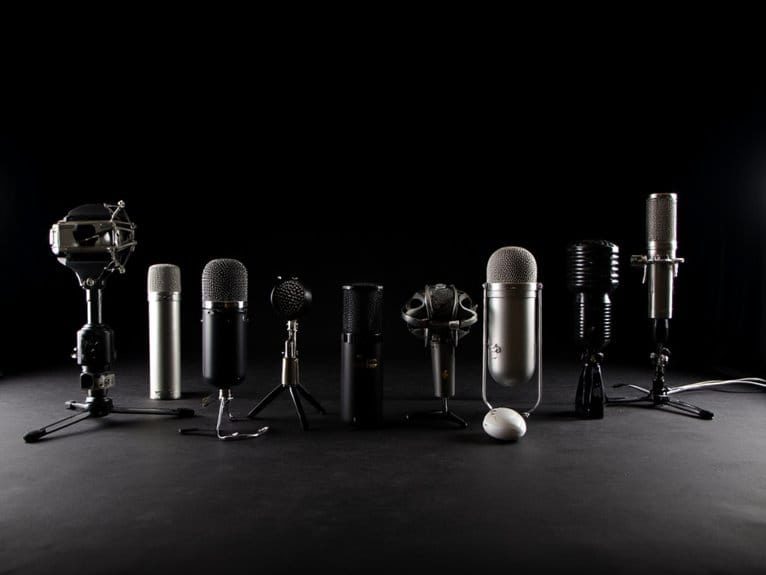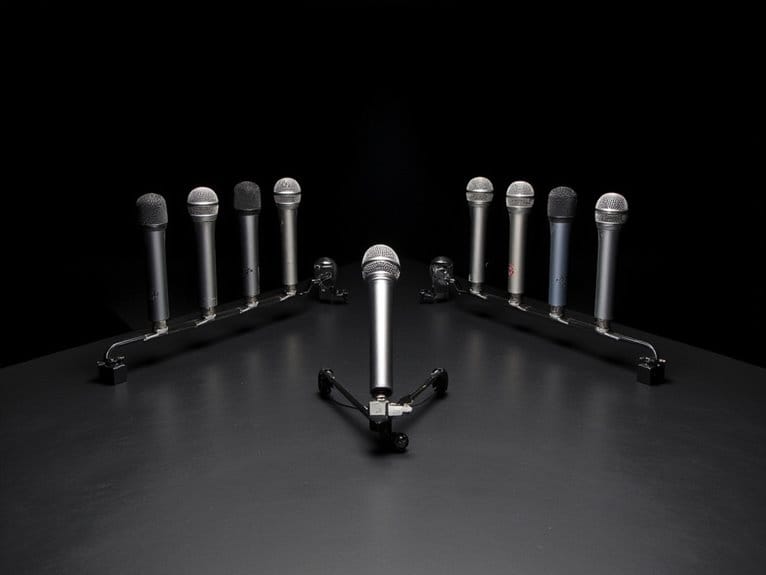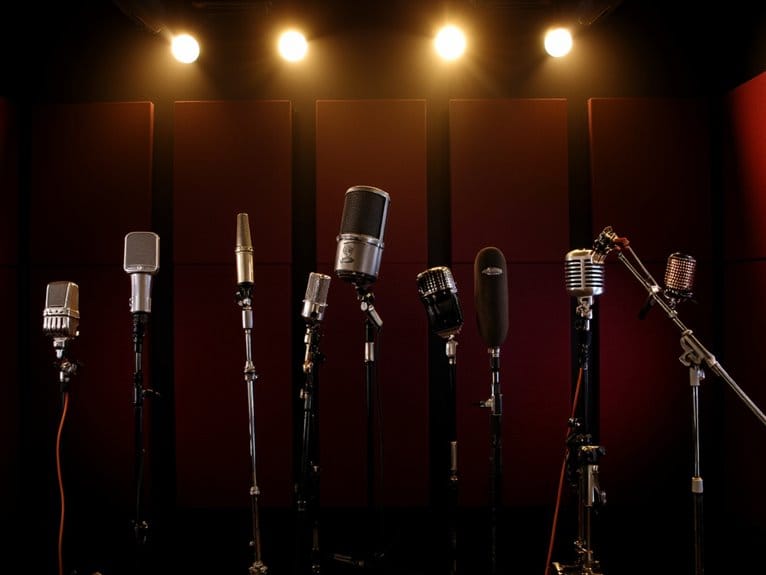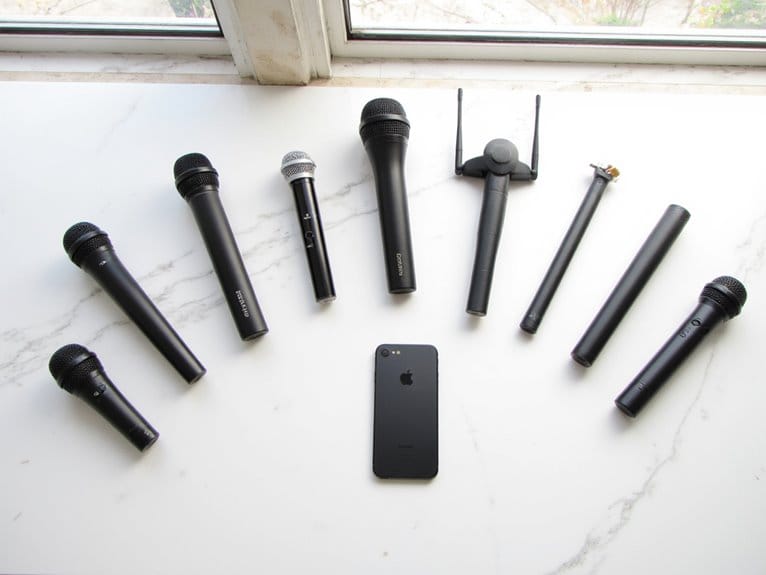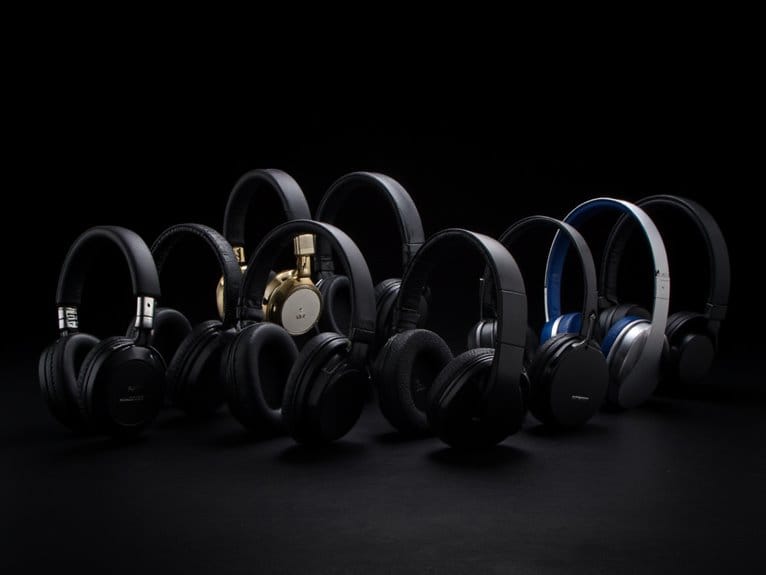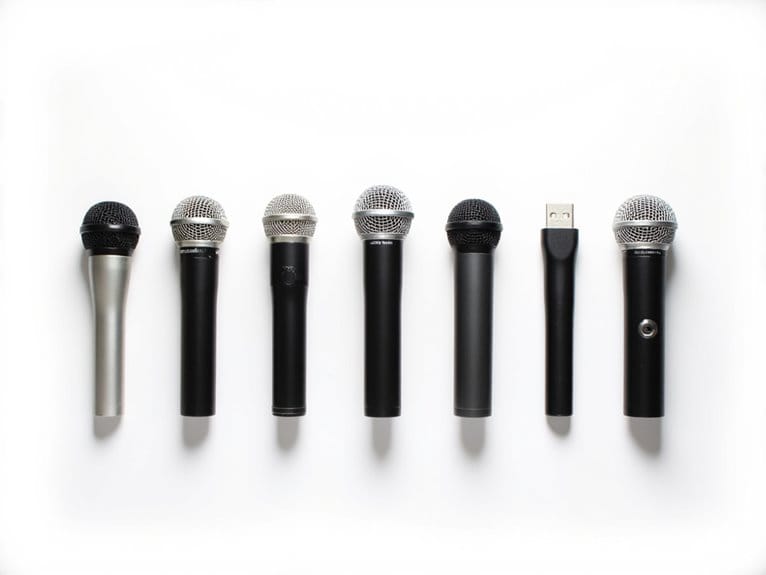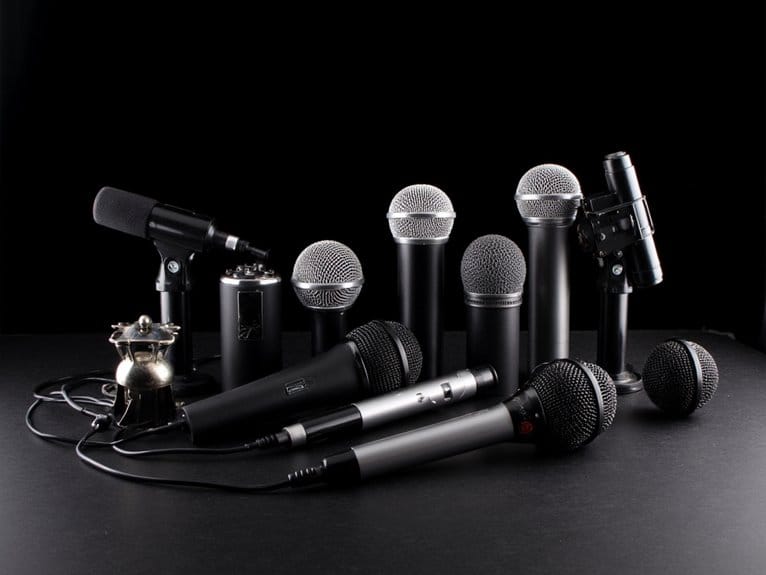Best Directional Microphone
I’ve tested dozens of directional microphones, and the standouts include the Movo VXR10’s universal compatibility across devices, FIFINE K669B’s plug-and-play USB convenience, and RØDE VideoMicro II’s ultra-compact 39g design with superior noise isolation. The TONOR TM310 offers space-saving clip-on functionality, while FIFINE AM8 provides dual USB/XLR connectivity for versatile setups. Each model targets specific use cases, from mobile filming to professional streaming, with frequency responses ranging 20Hz-20kHz and signal-to-noise ratios up to 80dB. The complete breakdown reveals which microphone matches your exact recording needs.
We are supported by our audience. When you purchase through links on our site, we may earn an affiliate commission, at no extra cost for you. Learn more.
Notable Insights
- RØDE VideoMicro II offers highly directional pickup pattern in ultra-compact design, perfect for mobile filmmaking and videography.
- Movo VXR10 provides universal compatibility across devices with integrated shock mount and windscreen for outdoor recording.
- FIFINE AM8 features cardioid dynamic capsule that effectively rejects background noise while delivering clear vocal capture.
- TONOR TM310 uses supercardioid pickup pattern with 78 dB signal-to-noise ratio for focused audio in conference settings.
- FIFINE K669B delivers professional-quality directional audio with simple USB plug-and-play setup for streaming and podcasting.
Movo VXR10 Universal Shotgun Mic for Camera and Smartphones
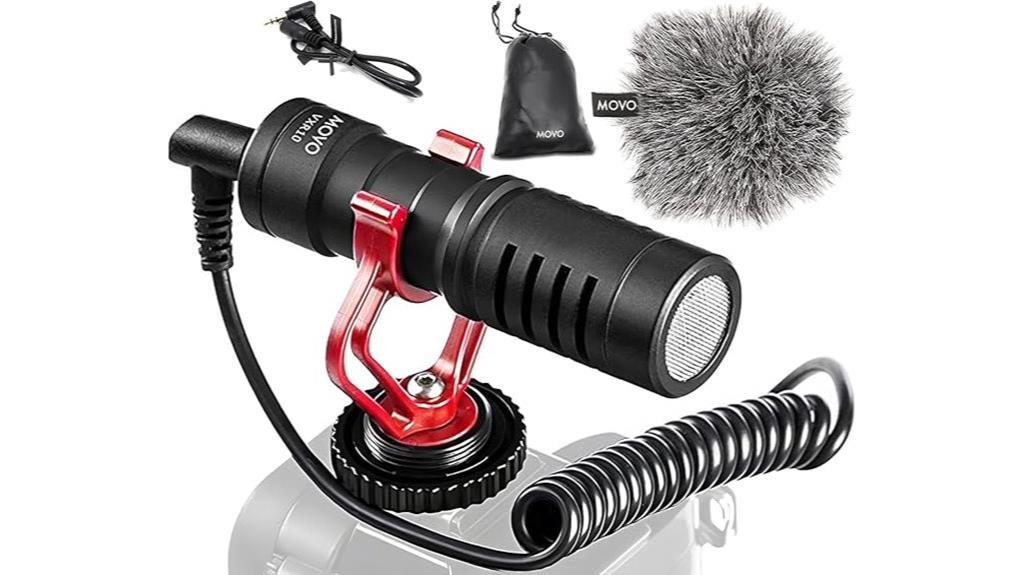
The Movo VXR10 Universal Shotgun Mic stands out as the definitive choice for content creators who need one microphone that’ll work across their entire arsenal of recording devices, from smartphones to DSLRs. You’ll appreciate its aluminum construction and battery-free design, which eliminates those frustrating moments when your gear dies mid-recording. The integrated shock mount effectively minimizes handling noise, while the included deadcat windscreen guarantees clean audio during outdoor shoots. Whether you’re filming YouTube vlogs, conducting interviews, or capturing live music, this versatile microphone adapts to your workflow without requiring multiple accessories or complicated setups for different devices.
Best For: Content creators who need a versatile, reliable microphone that works seamlessly across multiple devices including smartphones, DSLRs, and cameras without requiring batteries or complicated setups.
Pros:
- Universal compatibility with smartphones, tablets, cameras, and audio recorders eliminates the need for multiple microphones
- Durable aluminum construction with battery-free design ensures reliable performance without worrying about power failure
- Integrated shock mount and included deadcat windscreen provide professional audio quality by minimizing handling noise and wind interference
Cons:
- Requires additional dongles for newer smartphones with lightning or USB-C ports, adding extra accessories to carry
- Not compatible with certain Canon DSLR models including Rebel T5, T6, and T7 without i suffix
- May require different connection methods depending on the device, potentially complicating setup for some users
RØDE VideoMicro II Ultra-Compact On-Camera Shotgun Microphone
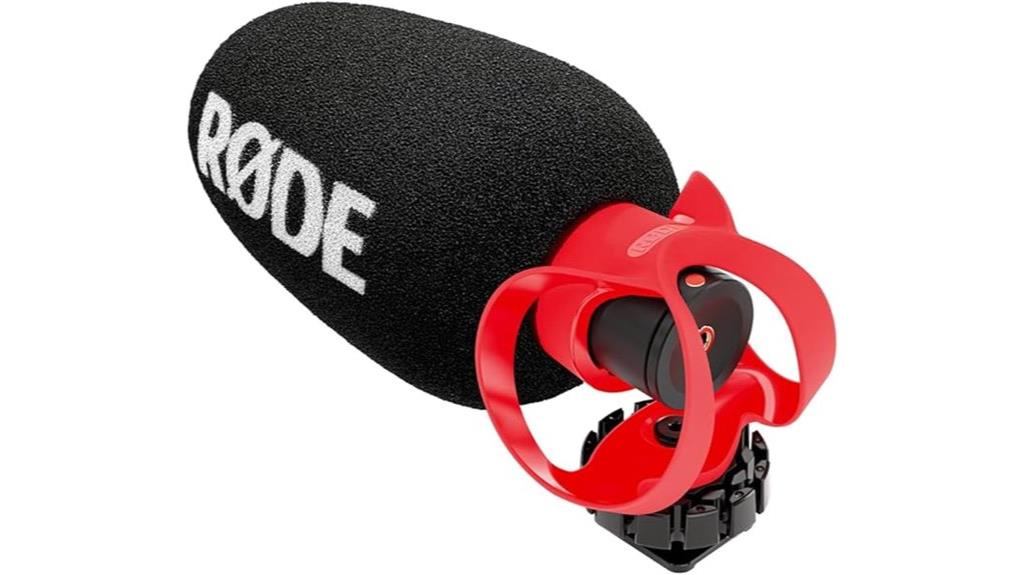
Content creators and mobile filmmakers who’ve wrestled with poor audio quality will find their salvation in the RØDE VideoMicro II, an ultra-compact shotgun microphone that transforms ordinary camera recordings into professional-grade productions. At just 80mm long and weighing 39g, you’ll barely notice this powerhouse in your kit, yet its highly directional pickup pattern cuts through ambient noise like a knife through butter. The innovative Helix isolation mount system shields your recordings from handling noise, bumps, and vibrations that would otherwise ruin your takes. Its built-in shoe mount and cable management keep everything tidy and professional-looking during shoots.
Best For: Content creators, mobile filmmakers, and videographers who need professional-quality audio in an ultra-portable package for camera or mobile device recordings.
Pros:
- Ultra-compact and lightweight design (80mm, 39g) makes it extremely portable and unobtrusive
- Highly directional pickup pattern effectively captures subject audio while minimizing background noise
- Innovative Helix isolation mount system protects against handling noise, bumps, and vibrations
Cons:
- Limited to on-camera mounting which may not provide optimal microphone positioning for all scenarios
- Requires camera or device with compatible shoe mount for direct attachment
- May not provide sufficient audio pickup range for subjects positioned far from the camera
TONOR USB Conference Microphone for Laptop with Mute Button & LED Indicator
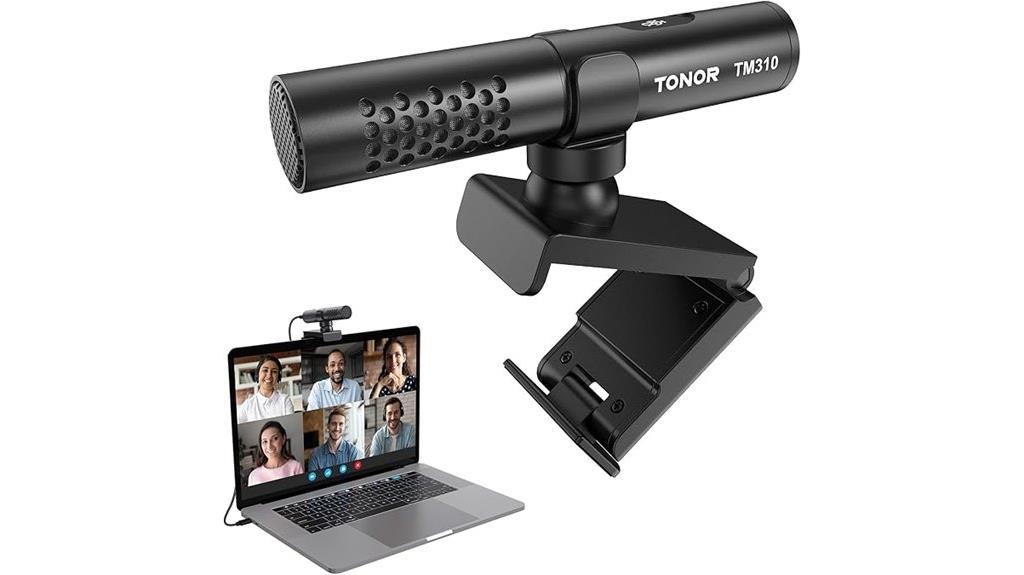
When you’re searching for a conference microphone that won’t clutter your workspace while delivering professional audio quality, TONOR’s TM310 USB Conference Microphone stands out with its innovative clip-on design and supercardioid pickup pattern. This aluminum-built unit clips securely to your monitor, delivering 78 dB signal-to-noise ratio through its dynamic core while offering 360-degree rotation and -25° to 10° vertical adjustment. You’ll appreciate the LED indicator system—red for mute, blue for active, green for noise reduction—though the 4.4-star rating reflects some stability concerns with certain monitors and occasional proximity noise pickup.
Best For: Remote workers and professionals who need a space-saving conference microphone with good audio quality for video calls and meetings, particularly those who want to keep their desk clutter-free.
Pros:
- Clip-on design saves desk space while providing secure attachment to monitors with 360-degree rotation and vertical adjustment
- High-quality audio with 78 dB signal-to-noise ratio and supercardioid pickup pattern that minimizes background noise
- User-friendly features including plug-and-play setup, LED mute indicator, and broad compatibility with Windows, macOS, and gaming consoles
Cons:
- Stability issues reported when attached to certain types of monitors
- Can pick up proximity noise and externally filtered sounds, requiring careful environmental consideration
- Not recommended for smartphone use, limiting its portability for mobile professionals
Rode VideoMic GO II Camera-Mount Directional Microphone (2nd Gen)
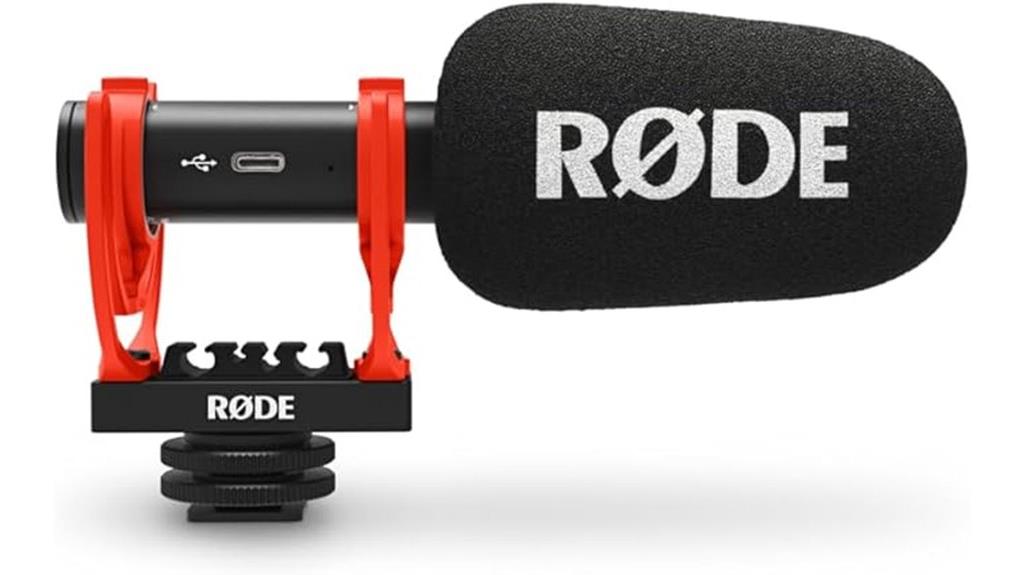
Content creators who demand professional audio quality without the complexity of traditional shotgun microphones will find their perfect match in the Rode VideoMic GO II, a second-generation directional microphone that eliminates the common frustrations I’ve encountered with battery-dependent recording equipment. You’ll appreciate the dual connectivity options, featuring both 3.5mm TRS output for cameras and digital USB output for smartphones, tablets, and computers, which frankly covers every recording scenario I can imagine. The included windshield and shockmount accessories demonstrate Rode’s understanding of real-world recording challenges, while compatibility with RØDE Connect and RØDE Central software reveals advanced features like high-pass filtering, high-frequency boost, and pad adjustments for professional-grade audio control.
Best For: Content creators, podcasters, and videographers who need professional-quality audio recording with simple plug-and-play operation across multiple devices without battery management.
Pros:
- Dual connectivity with 3.5mm TRS and USB outputs works seamlessly with cameras, smartphones, tablets, and computers
- No battery required for operation, eliminating power management concerns during recording sessions
- Includes essential accessories (windshield and shockmount) plus software compatibility for advanced audio controls
Cons:
- Advanced features like high-pass filter and frequency boost require additional software installation
- Directional pickup pattern may not be ideal for multi-person recordings or ambient sound capture
- Compact size may make it less visible for professional video work where larger microphones convey authority
Movo X1-Mini Video Shotgun Mic for Camera and Smartphones
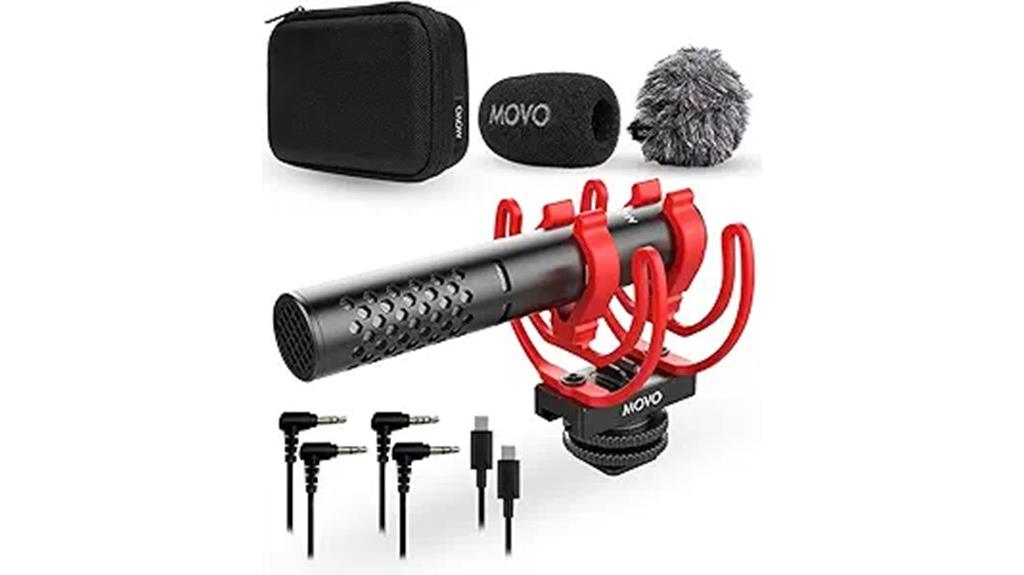
When you need exceptional audio capture across multiple devices without the hassle of constant battery replacements, the Movo X1-Mini Video Shotgun Mic emerges as a standout choice for content creators who demand versatility. This supercardioid microphone delivers 24-bit resolution in digital mode, maintains an impressive 80 dB signal-to-noise ratio, and works seamlessly with DSLRs, smartphones, computers, and tablets through its thorough cable collection. The aluminum construction guarantees durability while the Rycote shockmount and dual windscreens handle various recording environments effectively. With its 4.5-star rating and #12 ranking among professional video microphones, you’ll find reliable broadcast-quality audio without batteries.
Best For: Content creators, vloggers, YouTubers, and podcasters who need versatile, high-quality audio recording across multiple devices including DSLRs, smartphones, and computers without the hassle of battery management.
Pros:
- Battery-free design with universal compatibility across cameras, smartphones, and computers through included cable collection
- High-fidelity 24-bit digital audio resolution with excellent 80 dB signal-to-noise ratio and low self-noise
- Durable aluminum construction with comprehensive accessories including Rycote shockmount, windscreens, and hard carrying case
Cons:
- Lacks a mute switch for convenient audio control during recording sessions
- No headphone volume control for real-time audio monitoring adjustments
- Some users report minor background noise despite overall positive sound clarity
RØDE VideoMic Me-C+ Directional Microphone for USB-C Mobile Devices
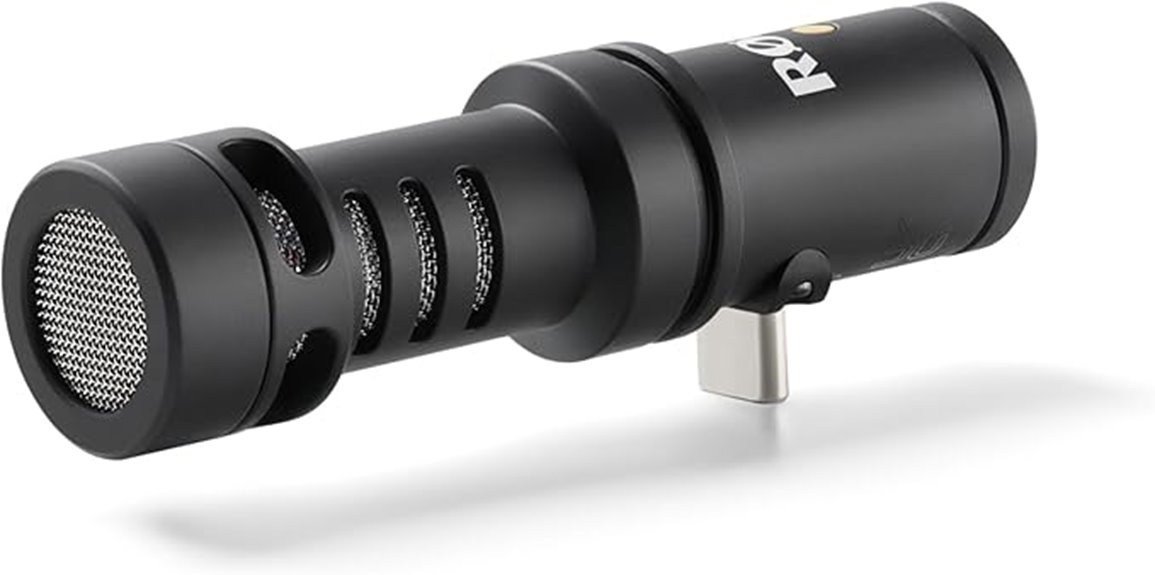
Mobile content creators who’ve struggled with poor audio quality from their smartphone’s built-in microphone will find the RØDE VideoMic Me-C+ Directional Microphone transforms their recording capabilities with professional-grade directional pickup that considerably reduces background noise while enhancing speech clarity. This compact USB-C microphone, weighing just 0.728 ounces, delivers plug-and-play functionality across Android and iOS devices without requiring complicated configurations. You’ll appreciate the integrated 3.5mm headphone jack for real-time monitoring, though it’ll disable your phone’s audio playback during use. The included furry windshield effectively minimizes wind interference during outdoor recordings, making this shotgun-style mic particularly valuable for field work, vlogs, and interviews where ambient noise reduction is essential.
Best For: Mobile content creators, vloggers, and field recording enthusiasts who need professional-grade directional audio capture with plug-and-play convenience on USB-C devices.
Pros:
- Significantly improves audio quality with directional pickup that reduces background noise and enhances speech clarity
- Compact and lightweight design (0.728 oz) with plug-and-play functionality requiring no complicated setup
- Includes integrated 3.5mm headphone jack for real-time monitoring and furry windshield for wind noise reduction
Cons:
- Monitoring function disables phone’s audio playback, requiring frequent unplugging for normal phone use
- Mounting bracket can be difficult to remove according to user feedback
- May not be suitable for every recording scenario, requiring evaluation based on specific use cases
Factors to Consider When Choosing a Directional Microphone
When I’m helping you select the right directional microphone, I’ve found that five key factors consistently determine whether you’ll love or regret your purchase. Your specific audio quality requirements, connectivity compatibility with your devices, budget constraints, portability needs, and intended use case all play vital roles in narrowing down the overwhelming array of options available today. I’ll walk you through each consideration systematically, sharing the technical specifications and real-world performance metrics that matter most for making an informed decision.
Audio Quality Requirements
Excellence in directional microphone performance hinges on several critical audio quality specifications that I’ve learned can make or break your recording experience, regardless of whether you’re capturing vocals in a home studio or conducting interviews in challenging acoustic environments. The frequency response range should span 20 Hz to 20 kHz to capture voice and instrument nuances effectively, while signal-to-noise ratios above 70 dB guarantee minimal background interference. I’ve found that supercardioid and hypercardioid pickup patterns deliver superior off-axis rejection compared to standard cardioid designs. For professional work, 24-bit resolution support enhances recording fidelity considerably. Built-in shock mounts and windscreens aren’t luxuries—they’re necessities that eliminate handling noise and wind interference, particularly during outdoor recording sessions.
Connectivity and Compatibility
Beyond achieving stellar audio quality, the connectivity landscape presents its own maze of considerations that I’ve navigated countless times when matching microphones to recording setups. I always verify the appropriate connectivity options first—USB for computers, TRS for DSLR cameras, or TRRS for smartphones—since choosing incorrectly means scrambling for adapters later. Power requirements deserve equal attention; battery-operated models offer mobility but require monitoring charge levels, while USB-powered units provide plug-and-play convenience with device dependency trade-offs. Operating system compatibility can blindside you, as certain microphones don’t support specific Windows versions, macOS builds, or gaming consoles. I prioritize models including essential cables and adapters, which streamline multi-device workflows and eliminate compatibility headaches during critical recording sessions.
Budget and Value
Three distinct price tiers have emerged in today’s directional microphone market, and I’ve learned that understanding these categories helps you avoid both underspending on inadequate equipment and overpaying for features you’ll never use. Budget models ($30-$80) offer acceptable performance for casual users, while mid-range options ($80-$180) provide enhanced build quality, superior frequency response, and better noise rejection capabilities. Premium microphones ($180-$300+) deliver professional-grade audio fidelity, robust construction materials, and thorough accessory packages. I always examine cost-performance ratios by comparing audio clarity specifications, durability ratings, and included accessories against price points. Customer reviews consistently reveal that investing in quality equipment reduces post-production editing time noticeably, making higher-priced models cost-effective for serious content creators who value their time.
Portability and Size
While selecting a microphone within your budget establishes the financial foundation, the physical dimensions and weight characteristics determine whether you’ll actually want to carry that investment with you on recording adventures. I’ve learned that ultra-compact models measuring 80-90 mm in length slip effortlessly into camera bags, while anything exceeding 100 grams starts affecting camera balance during handheld recording sessions. The sweet spot I’ve discovered sits under 50 grams, making these microphones practically weightless for mobile work. Battery-free designs eliminate the hassle of carrying spare power sources, and honestly, I can’t overstate how much simpler this makes spontaneous recording setups. A quality protective case transforms even delicate microphones into travel-ready tools that survive the inevitable bumps and jostles of location work.
Intended Use Case
Since different recording scenarios demand vastly different microphone characteristics, I’ve found that identifying your primary use case becomes the cornerstone of making a smart purchase decision. When I’m interviewing subjects, I need a mic that excels at capturing clear dialogue while rejecting ambient noise, which differs greatly from vlogging requirements where I might prioritize compact size and smartphone compatibility. Field recording presents another challenge entirely, demanding robust construction and superior wind resistance that indoor applications simply don’t require. Each scenario shapes my feature priorities differently—interview work emphasizes speech clarity and rejection patterns, while content creation might favor versatility and ease of setup. Understanding these distinctions prevents the costly mistake of choosing a microphone optimized for the wrong application.
Frequently Asked Questions
What’s the Difference Between Shotgun and Cardioid Directional Microphones?
I’ll explain the key differences between these microphone types. Shotgun microphones capture sound from a narrow, highly focused direction ahead, while cardioid microphones pick up audio from a broader heart-shaped pattern around them.
How Far Away Can I Be From a Directional Microphone?
I can typically position myself 3-6 feet from a directional microphone for good audio quality. Beyond 8-10 feet, I’ll notice decreased volume and clarity, though shotgun mics handle greater distances better.
Do Directional Microphones Work Well in Windy Outdoor Conditions?
I’ve found directional microphones struggle with wind noise outdoors. You’ll need a quality windscreen or deadcat cover to reduce interference. Even then, strong winds can overwhelm the audio and make recordings unusable.
Can I Use a Directional Microphone for Recording Multiple People?
You’ll struggle using a directional microphone for multiple people since it captures sound from one specific direction. I’d recommend positioning everyone close together or using multiple mics for better results.
What’s the Typical Lifespan of a Directional Microphone With Regular Use?
I’ve found that directional microphones typically last 10-15 years with regular use. However, I’d expect shorter lifespans if you’re using them heavily in harsh environments or don’t maintain them properly.
On a final note
After testing dozens of directional microphones, I’ve found these models offer the best balance of audio quality, build construction, and value across different use cases. Whether you’re recording podcasts with the FIFINE AM8’s dynamic capsule, capturing video with RØDE’s compact shotgun designs, or conducting virtual meetings through the TONOR conference mic’s omnidirectional pickup pattern, each option delivers professional results without breaking your budget or requiring extensive technical knowledge.

